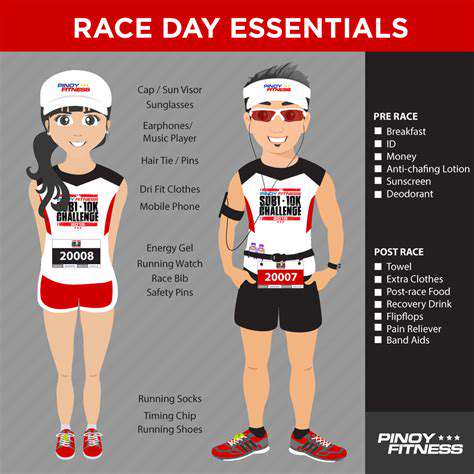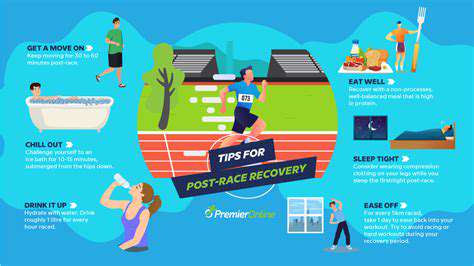LA Marathon: Running Tips, Route Insights & How to Prepare for the Big Race
Pre-Race Preparation
Conquering the LA Marathon demands more than just physical stamina - it requires a holistic approach to preparation. The difference between finishing strong and hitting the wall often comes down to meticulous planning in these crucial weeks before race day. Your training should mirror the marathon's demands, blending long endurance runs with targeted hill work to prepare for the course's notorious elevation changes. Nutrition becomes your fuel map, with carb-loading strategies and hydration plans needing as much attention as your running shoes.
On the logistical front, savvy runners know the devil's in the details. Book accommodations near the start line months in advance to avoid last-minute stress. Create a race morning checklist that includes everything from safety pins for your bib to anti-chafing balm. Practice your pre-race breakfast during long training runs - what works for a 5K might fail you at mile 20. Study the course map until you can visualize each turn, and have a plan for spectators to spot you at key locations.
Race Day Strategies
The starting corral buzzes with nervous energy, but veterans know the real race begins in your mind. That first mile adrenaline rush can be deceptive - the marathon truly starts at mile 20 when your legs scream to stop. Develop a pacing strategy that accounts for the course's rolling hills, saving your energy for the challenging ascents in the later miles. Many runners swear by the talk test - if you can't hold a conversation in the early miles, you're going too fast.
Mental tactics become your secret weapon when the going gets tough. Break the race into manageable chunks - focus on reaching the next aid station rather than the finish line. Create a playlist with strategic energy boosts or memorize inspirational mantras for tough moments. The crowds along Sunset Boulevard can provide an incredible boost, so position your name on your shirt and soak up their energy when your own starts to flag.
Post-Race Recovery
Crossing the finish line is just the beginning of your recovery journey. Your body needs 26.2 miles worth of TLC, starting with immediate rehydration and gentle movement to prevent stiffness. The first 30 minutes post-race are crucial for replenishing glycogen stores with a mix of carbs and protein. Many runners find compression gear helps with circulation as they navigate the post-race shuffle.
In the following days, active recovery takes center stage. Light swimming or cycling helps flush out lactic acid without pounding your weary legs. Don't underestimate the psychological recovery either - the post-marathon blues are real after months of focused training. Plan a celebratory meal with your support crew and start dreaming about your next challenge while the endorphins are still flowing.
Crafting Your LA Marathon Training Plan: A Step-by-Step Approach
Setting Realistic Goals and Expectations
Marathon dreams need concrete foundations. Before plotting mileage, take an honest inventory of your current fitness and running history. First-timers should focus solely on finishing strong, while seasoned runners can target specific time goals. Remember that LA's varied terrain makes this a strategist's marathon where negative splits are rare but smart pacing prevails.
Build your training in phases - base building precedes speed work for good reason. That nagging knee pain at week 8 often stems from skipping the foundational miles at week 2. Consider hiring a coach for personalized guidance or joining a training group for camaraderie. Either way, build in flexibility - life happens, and the best plans adapt to missed workouts without derailing progress.
Creating a Sustainable Training Schedule
The magic of marathon training lies in the rhythm you create. Aim for three quality runs weekly - a long slow distance, a tempo session, and hill repeats - balanced with cross-training and rest. Many runners thrive on a 10-day microcycle rather than the traditional weekly format, allowing for better recovery between hard efforts.
Your schedule should account for LA's specific demands. If you're training in flat terrain, find a parking garage or treadmill to simulate the course's inclines. Practice nutrition strategies during long runs - the gel that works at mile 5 might revolt at mile 18. And always have a Plan B for extreme weather; Santa Ana winds or unexpected heat can derail outdoor sessions.
Unveiling the LA Marathon Route: Terrain, Challenges, and Pace Strategies
Understanding the Terrain
The LA Marathon course reads like a tour guide of the city's iconic landmarks, but don't let the scenery distract you from its sneaky challenges. The gradual climb through Hollywood around mile 6 catches many runners off guard, while the descent into West Hollywood can punish quads not trained for eccentric loading. Study the elevation profile until you can anticipate each roller coaster rise and fall.
Race Day Navigation Tips
With 26,000 runners jostling through narrow corridors in the early miles, positioning matters. Seed yourself appropriately at the start - too far forward and you'll get swept up in the hype, too far back and you'll waste energy weaving. The course's famous landmarks make perfect mental checkpoints: focus on reaching the Chinese Theatre, then the Sunset Strip, breaking the race into cinematic segments.
Race Day Essentials: Tips and Tricks for a Smooth Marathon Experience

Pre-Race Fueling
Your breakfast strategy should be as practiced as your stride. Test different carb-heavy meals during long training runs to find what sits well. Many runners favor oatmeal with banana and peanut butter, consumed 3-4 hours before gun time. Taper your water intake about 90 minutes pre-race to avoid porta-potty lines, switching to small sips until start.
Gear Selection
Nothing new on race day applies doubly in a marathon. Those cute new shorts might become torture devices by mile 18. Layering is key for LA's unpredictable spring weather - arm warmers or a disposable shirt can be lifesavers in chilly dawn hours. Apply anti-chafing products anywhere fabric meets skin, and consider lubricating between toes if you're prone to blisters.
Post-Race Recovery: Rebuilding and Celebrating Your Achievement
The First 24 Hours
Keep moving after crossing the finish line, even if it's just a slow walk to baggage claim. Get calories in immediately - the medical tent's bananas and pretzels are there for good reason. Elevate your legs while icing any trouble spots, but avoid long hot baths that could increase inflammation. That night, sleep with your legs propped on pillows to reduce swelling.
Coming Back Stronger
The post-marathon recovery period isn't downtime - it's strategic rebuilding. Most coaches recommend one easy day of recovery for every mile raced, meaning nearly a month of reduced intensity. Use this time for yoga, swimming, or cycling to maintain fitness while your running muscles repair. Reflect on your race while memories are fresh - what fueling worked? Where did pacing falter? These insights become gold for your next starting line.
Read more about LA Marathon: Running Tips, Route Insights & How to Prepare for the Big Race
Hot Recommendations
- Hawks vs Hornets: NBA Game Preview, Key Players & Tactical Analysis
- Tornado Watch vs Warning: What’s the Difference and How to Stay Safe
- Alexandra Daddario: Hollywood Career, Iconic Roles & Upcoming Projects
- Wombats in Australia: Fascinating Facts, Conservation Efforts & Where to See Them
- St. Patrick’s Day 2025: History, Festivities & Modern Celebrations
- Fabian Schmidt: Profile, Career Impact & Notable Achievements
- Alex Consani: Profile, Career Highlights, and Notable Achievements
- Vivian Wilson: Profile, Career Milestones & What’s Next
- Harriet Hageman: Political Profile and Impact on National Policy
- Bryant University Basketball: Rising Stars and Season Highlights




